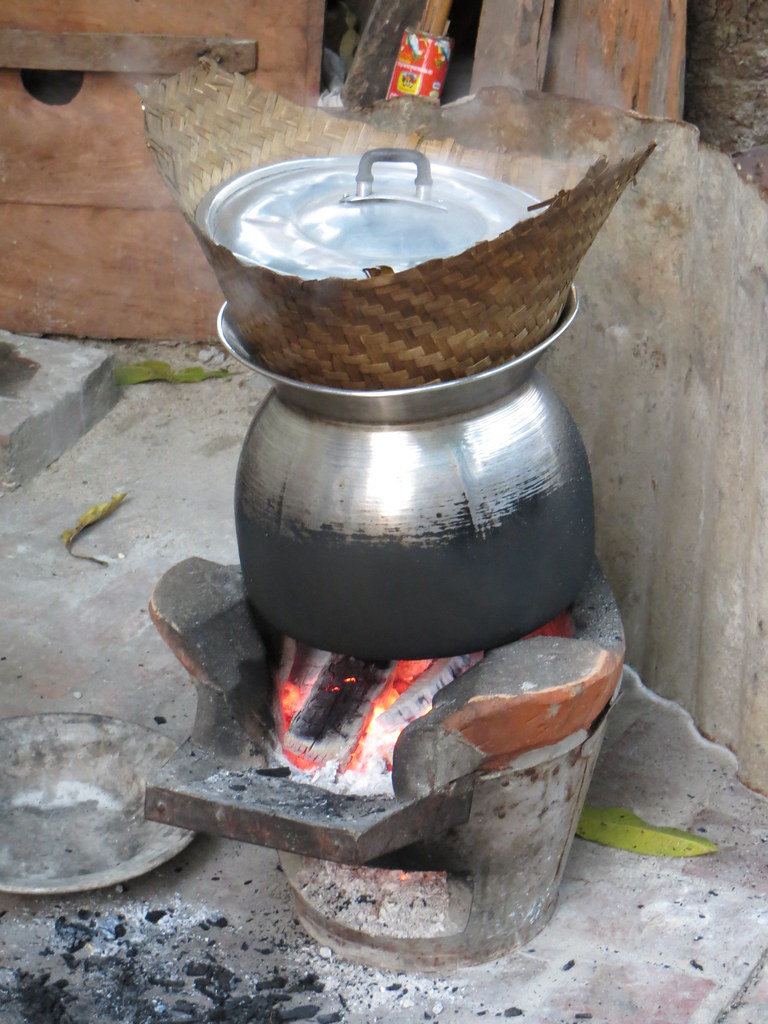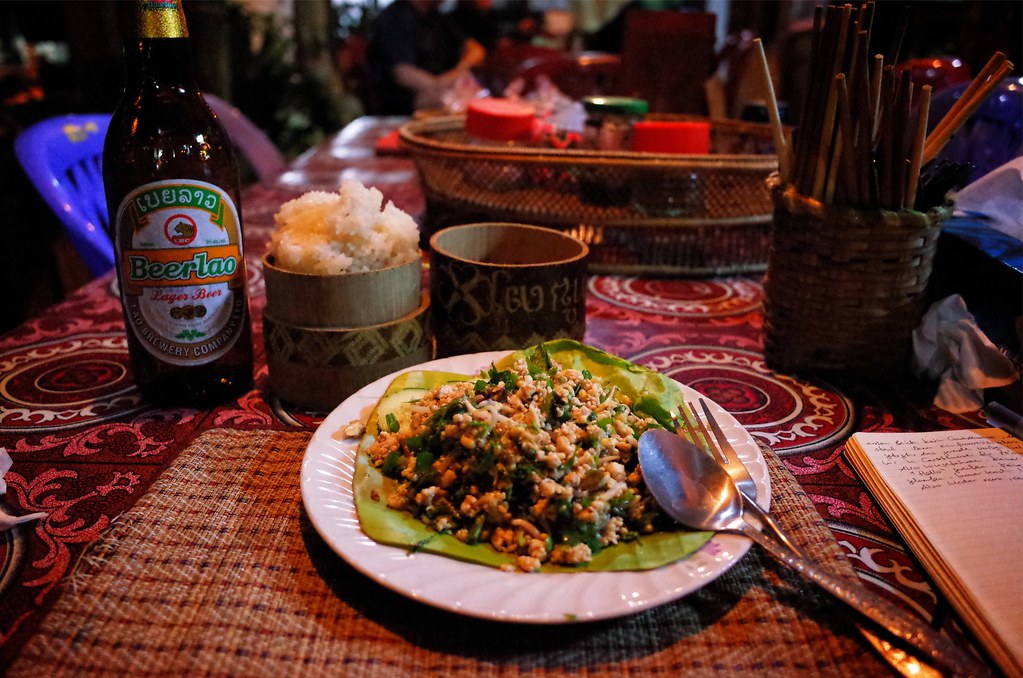
Continued From: What is Lao food? Part 1
~
Lao food today:
Lao food is still considered an exotic/rare cuisine by many people, although its popularity and availability is on the rise, especially in the capital cities. Lao dishes such as “ping lin” (grilled ox tongue), raw “larb”, or “tum mark hoong” (spicy green papaya salad) with preserved crab – once considered too spicy or “a little unusual”, are now sort after by many adventurous/seasoned foodies.
For the more experienced/veteran foodies, there are other unsung Lao dishes that may also whet your appetite, including “gaeng nor mai” (bamboo stew), “jeow het” (spicy mushroom relish), “khao piak sen” (Lao noodle soup), etc. This food trend is evident with other world cuisines too – a result of a multicultural/interconnected world community, and for the better, I say. 1
Globalization, multiculturalism, media and social media have all played a big influence on the popularity of Lao food. As the Lao diaspora across the world continue to perpetuate their identities in their communities – Lao food has naturally become a topic of interest. When Lao people integrate – they also share with their communities, a part of Lao culture including Lao food.
Gatherings such as weddings, bbqs, karaoke parties, etc. are all great moments to experience and share both Lao culture and Lao food. Across the globe, Lao restaurants/eateries have opened up, albeit sporadically – further unveiling Lao cuisine. Lao food has secured a spot on the culinary stage/limelight – as a niche cuisine/a break from the mass, and rightfully so because Lao food is absolutely delicious! Lao people and Lao food are standing lao’d and proud – more so than ever.
Lao food in Laos:
There’s astonishing change happening within Laos atm. The once closed/private country has inevitably opened up and more tourists/travellers are entering and exploring the country, discovering its unique culture and cuisine. Lao food – once a mystery is now the new darling for travelling foodies.
Exotic food discoveries and experiences in Laos have been photographed, written about and shared on and offline – helping spread the love of Lao food and enticing more foodies to seek out and experience it. The mysterious cuisine of Laos is steadily building a following of fans – although, some dishes/ingredients might still be too foreign/novel for some people, but when in Laos…?
There’s a variety of Lao restaurants/eateries in Laos to cater for most tastebuds/preferences, along with other cuisines too. Besides sharing a traditional meal with a Lao family, some of the best places to eat real Lao food is at street eateries/pop up food stands, etc – where you’ll be spoilt for choice with affordable/tasty/authentic Lao meals/flavours. Be sure to consider some of these food stands when you’re in Laos – following the crowd or simply your nose is a good guide to finding some of the choice places to go to.
Alternatively, if you want to eat in a restaurant – among others, some notable restaurants in Laos to consider include, The Boat Landing, Makphet, Tamarind, 3 Nagas, Vang Vieng Organic Farm, etc. If you’re really serious and want to experience/learn more about Lao food, consider participating in a Lao cooking class like the ones offered at Tamarind in Luang Prabang. Not only will you cook/learn about some Lao ingredients and prep methods, you’ll also eat/enjoy the fruits of your labour.
Lao food outside of Laos:
Outside of Laos, Lao food continues to nourish Lao families and friends far and wide. The Lao diaspora is scattered across the world – from Australia, to the US, France, England, Ireland, etc. (a shout out to all the Lao folks out there!). Naturally, Lao families maintain their culture and traditions, including preparing/cooking Lao food, and passing it on to their children and sharing it with their friends.
As the public interest on Lao food increases, once rare Lao restaurants are becoming more accessible (although still few and far between compared to other cuisines). This interest in Lao food and culture benefits the Lao community as it’s a symbol of acceptance and praise, which in turn builds and gels the wider community together.
Lao restaurants/eateries across the globe vary from food trucks (Sang On Wheels, Green Papaya Food Truck), to traditional (Lao-Thai Luammit), fusion (Lao Thai Soul Food Kitchen), modern (Baan Latsamy, Holy Basil, Bangkok Golden, Khe-Yo), to specialties (Lao Food In Cork, The Papaya Lady), etc.

Khao piak sen is one of my personal favourite Lao dishes, and I know an awesome recipe. It’s delicious, especially on cold/wet days, and with extra chili oil and congealed blood cubes – yum! I’ll post the recipe soon – I promise.

Lao restaurants are still as rare as hen’s teeth, although gems like Lao Laan-Xang in Madison, Wisconsin can be found.

Food for thought:
A Lao food movement as described by Chef Seng is happening before our eyes. The presence of Lao food is clearly evident online, including on the highly popular Lao Food Facebook page, YouTube (Cooking with Nana) and websites/blogs (Nye Noona, Sao Darly, Lao Cook, Devonium), etc. 2
Besides the recipes that you can find online, especially from Nana’s YouTube videos, there are also a selection of Lao cookbooks that you may be interested in reading, including Traditional Recipes of Laos by Phia Sing, Food From Northern Laos: The Boat Landing Cookbook, etc. There are more Lao cookbooks out there – please do a google search.
I have observed and it’s interesting to note that as Lao food enters the mainstream, it has become subject to change/modifications. Traditional Lao dishes that originally use certain ingredients/prep methods/flavours have become altered to suit modern/special palates/needs. This has made me think about what is happening to the nature of traditional Lao cuisine.
It is a natural/inevitable process for food/dishes/recipes to evolve and be altered to suit certain dietary requirements, eg: allergies/vegetarian diets etc, and also change as reflection of modern trends, but what effects will this have on the definition of Lao food? Will it dilute the true essence of Lao food? Is it still Lao food if it does not taste/look like traditional Lao food? What are your thoughts on this?
Conclusion:
As a Lao-Australian artist and home cook – I am fascinated with new ideas and inventions/explorations/experiences. I am all about exploring new flavours/methods/ingredients, and adapting/redefining recipes – although, at the same time, I also love and respect humble, earthy, original/true, simple flavours/dishes, which is what makes Lao food so special in the first place. I think that while it’s inventive and pioneering to experiment and explore new flavours/recipes, it’s also important to uphold old traditional customs/dishes and protect them too. I find it completely natural to appreciate and enjoy both of these views, and endorse it too.
Among others, I am inspired by the works of Vienne aka Lao Cook, Chef Seng, and Chef Soulayphet Schwader at Khe-Yo. In Australia, and among many others, I am inspired by the works of Kylie Kwong (Chinese-Australian chef), who’s mastery of traditional/modern Australian/Chinese cooking methods/flavours in combination with local/native produce is admirable.
I think food plays a massive part in defining and building culture and identity. It reflects our past and offers guidance for the future. It’s also the vehicle that connects/brings us together. One of my goals with food is to help contribute to the definition of Lao food/cuisine by incorporating and balancing/respecting both traditional and modern recipes/methods/ingredients/ideas to create something that is delicious and good. Big dreams, I know.
I am currently working on some new Lao recipes (new to me at least) – one of which is a modern larb inspired recipe/dish. As an artist, some of my ideas look great in my mind, but don’t necessarily work out in reality – lol. Only time will tell and I’ll keep you posted on how these recipes are developing.
Lao food like all food is good food and delicious, however you’re enjoying it. Like all food, it tastes best when it’s shared with family and friends – “kin khao sap num gun der”. 3
The End.
Notes:
- To me, SBS Food has been one of the key promoters/supporters of world/multicultural cuisines in Australia, including Lao food and I am very thankful for this. Multicultural food is the best! ↩
- Here are other (non-exhaustive) Lao food related blogs/websites: House on the Mekong, Food From Northern Laos, So Many Miles. If you know of other Lao food websites that you would like to share, please feel free to let me know by emailing me or leaving a comment below. ↩
- This Lao phrase translates to “may you enjoy your meal together”. ↩